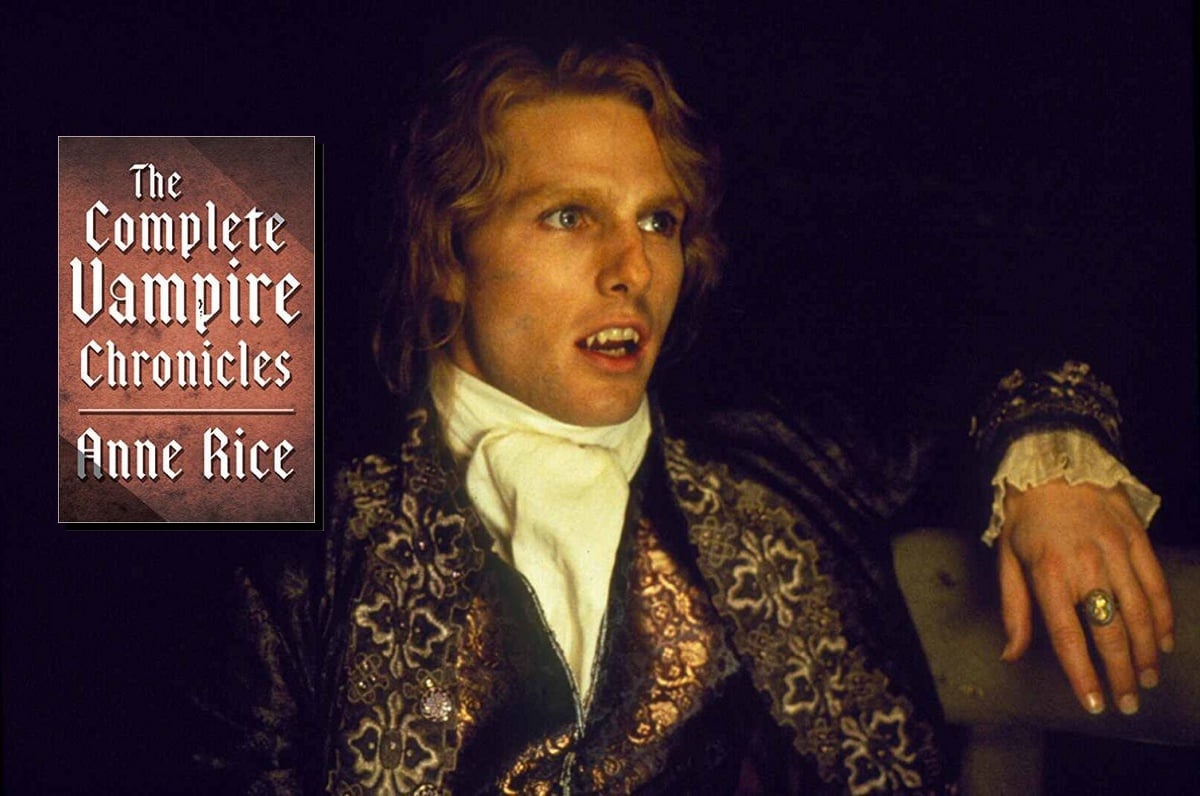Anne Rice’s The Vampire Chronicles are a staple of any vampire lover’s library, and her first installment in that series, Interview with a Vampire, is truly a piece of gothic vampire excellence that introduced us to Lestat de Lioncourt and his lover Louis de Pointe du Lac.
So much of the pop culture framework we have for the vampire can be traced back to Anne Rice’s series. After Dracula and Carmilla there really isn’t another early vampire book that has had more of an impact on the way that vampires are portrayed. The brooding, self-flagellating romantic vampires that we know and love are not from 19th-century literature, where vampires were clearly more monstrous, but from Rice’s 1976 novel and the character of Louis.
Interview with a Vampire is a first-person novel where the character of Louis tells his life story to a reporter, hence the title. He explains how he was a beautiful young man once, who after the death of his brother feels suicidal, but afraid to take his own life. One day he catches the eye of Lestat, and as a song once said: “never trust a big butt and a smile.” Lestat is a vampire who “seduce[s] the tenderness” in Louis after falling in love with the dark-haired, green-eyed brooding young man (relatable) and turns Louis into a vampire. Lestat, having gone through his own trauma, is not a good mentor, lover or partner and emotional manipulates Louis throughout their seventy-year-old relationship.
I would be … lying if I didn’t say that a huge part of the reason I love Interview is because of the queer relationship undertones between Louis and Lestat throughout the series, especially in this book. Vampires, like all supernatural creators who shift between human and creature in some way, end up being a metaphor for queerness, but vampires, second to say, witches, tend to be the gayest of supernatural creatures. They are inherently seen as phallic, since their main method of feeding to have their teeth elongate and penetrate the sensitive exposed neck of their victims.
Interview with a Vampire is really the first time the humanity of a vampire is talked about: Louis as the broody Byronic vampire is the template for everything we get in the future and just like every version of this story, he has a foil who is more comfortable with his vampirism in Lestat.
Lestat was fabulous, sublime, the seductive vampire who made you long for his bite rather than the inward and outwardly monstrous Draculas that media had. The pathos that Rice put into her vampires made them intriguing, and while now the angsty vampire is not anything special, back then the series really raised existential crises about what it meant to be human and if you could have ties to your humanity when you are no longer tied to humanity in any way other than a beautiful face.
Also, much like Twilight years after it, Interview was also called out for making vampires “soft” and “sissies” because no longer were vampires just coded as queer, Rice pretty much made all her vampires bisexual and you’d have to have serious blinders on to think that Louis and Lestat weren’t a couple. What that representation means in terms of being a positive or negative is something still being discussed today.
For me, Interview with a Vampire, the character of Lestat, and many of Rice’s books (I personally love the Mayfair witches books the most) have enduring appeal because they did something new with a monstrous creature and did it well. The modern vampire wouldn’t exist without Lestat and even if Stephenie Meyer denies really knowing much about vampires and its history, she basically created Louis 6.0 with Edward Cullen. Even when it can be over the top, Rice infuses her characters with such beautiful emotion that even when you get sick of Louis’ brooding you still understand why he does it because of the sensitive person he was before he became a vampire.
The desire to be loved, to understand what it means to be human when your humanity is stripped away from you, those are beautiful themes and questions to raise in a novel about vampires. Rice showed the poetry in the genre and also gave women a stronger place in vampire literary lore. She wrote vampires for a female audience while creating a brutal and dark novel with Interview, but it was dark not just through violence but through emotion—and that is why the series means so much to people even now.
Anne Rice published another installment in this series, which was released yesterday, called Blood Communion: A Tale of Prince Lestat, and I find myself still excited. I’m excited because even now, nothing has replaced what a deep impact The Vampire Chronicles had. Yes, Twilight was super successful and has its fandom, but at a little over ten years old, as a series it has really burnt out fairly quickly. While Lestat only burns with the hellfire he himself rules.
(image: Warner Bros. Pictures/Random House / Ballantine Books)
Want more stories like this? Become a subscriber and support the site!
—The Mary Sue has a strict comment policy that forbids, but is not limited to, personal insults toward anyone, hate speech, and trolling. If you purchase something through our links, The Mary Sue may earn an affiliate commission.—










Published: Oct 3, 2018 11:43 am